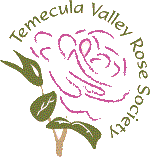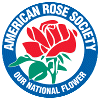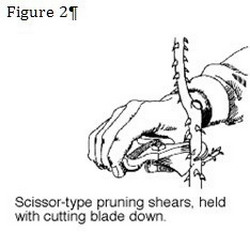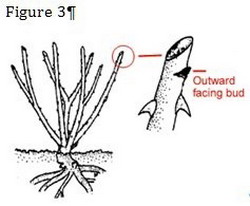Jump to this month's program
Jump to Frank Brines' FUNdamentals
Jump to Calendar of Events
All product names, logos, and brands are the property of their respective owners. All company, product and service names used in this newsletter are for identification purposes only. Use of these names, logos, and brands does not imply endorsement.
President's Message
by Virginia Boos

You've heard of State of the Union and State of the City presentations, usually around the first of the year? Here is my own State of the Rose Society report.
Membership – increased by nearly 100% during 2019. Renewals are doing well.
Finances – The budget 30 years ago was $250, mostly for newsletter printing and mailing, after it was hand-typed. Rose Haven work was done by volunteers, sometimes at our late afternoon work parties / picnics, but the garden was much smaller then.
The current budget is now in the thousands, covering maintenance, repairs, utilities and taxes at Rose Haven, liability insurance, library room rental, hospitality and membership dues. Long-term funding is established as well as our ongoing fundraising efforts.
Committee Volunteers – This will be the year of the volunteer. Help is always needed for our many tasks .
RH Committee (now 14 members). This committee is working hard to maintain and improve the garden. Current media writing indicates that there are health benefits from gardening and learning new skills. Yoga classes have been held at RH by a Rancho Medical team.
Let's make 2020 a great year. We can do it together.
In Memoriam
Personal News
by Virginia Boos
It's always a sad news item – the death or serious illness of one of our members. A quick poll of our group showed that we would want to know this news, so it will be included as appropriate.
Earlier in 2019 we learned from her husband Steve that Jeanne Brubaker had passed away. She served on the Board of Directors, the Finance Committee and helped with the raffle table. She was a member for about 10 years. I always got a big hug from her. She loved the lavender 'Royal Amethyst'.
Ellen Noelle's daughter sent a note that she had passed away a few months ago. She always brought her blooms for the Little Rose Show, even when she was ill and feeling weak. 'Ketchup and Mustard' was a favorite of hers. She and Louie were members for about 20 years.
Simonne Arnould suffered a serious stroke and has not yet been able to return to the meetings. She served on the Board and many committees and as President in 2001 and 2002. A member for 25 years, she was another one of our faithful exhibitors in the Little Rose Show.
What You Don't Know About Me
by Virginia Boos
Members have asked for autobiographies, so here are a few facts about me.
I'm first generation American, with both parents born in Germany. They met in Detroit, Michigan and I was their 9th child. (That isn't done any more!) After high school I met Roy (WW-2 sailor) and we were married in 1946. We have 3 children, 6 grown-up grandchildren and 1 great-grandson. After the early child-raising days, I started working again. I also pursued my AA degree, completing it at age 55. I know Gregg shorthand! And I used to dance a mean cha-cha.
Rose Haven Happenings
by Rebecca Weersing
Pruning will continue throughout February. If you are an experienced pruner and feel comfortable pruning on your own, show up on any day and work in any section of the garden except Hall of Fame and the Garden Entrance /Boos Courtyard. These garden areas are being rehabilitated. If you would like to assist with the rehabilitation, send a message to Rose Haven Committee@gmail.com for information. If you want to prune when others are there, any February Saturday at about 9 a.m. you will find a Pruning Partner. Any bush not pruned by Saturday, February 29 will be subject to Nardo's hedge trimmers.
Tuesday, February 4: Those interested in helping to plan "Gardening is for the Birds", join us at Rose Haven at 10 a.m. in the Pavilion.
Saturday, February 15: Families in the Garden program, titled "Gardening is for the Birds", begins at 9:30 a.m. Families with children 12 and under will find many exciting gardening activities to enjoy.
Saturday, February 29: We invite the community to join us on the Fourth Saturday (10 a.m.) and experience some aspect of rose growing. On this Saturday we will share information about selecting, planting and fertilizing roses. If you would like to help with the program, send a message to Rose Haven Committee@gmail.com for information.
School Garden Roses
by Rebecca Weersing
La Vorgna Elementary: Thank you to Members Nancy Fitness and Judy Sundermann plus Garden Club Member Sharon Johnson (active with the Garden Club's School Gardens Outreach) for assisting with rose pruning at La Vorgna Elementary on January 29th. The bushes had not been pruned in several years and were totally in need of severe pruning.
During last December a non‑gardening group of volunteers came in to do a mass cleanup of the garden beds for the students. In addition to weeding, painting boxes, clearing pathways, and refurbishing soil someone did take a chainsaw to the roses, chopping them down from nearly 6 feet to a manageable 3 to 4 feet. Please do remember that "Chainsaw Pruning" or "Gross Pruning" is an approved method of pruning under certain circumstances. Drastic measures, yes, but allows you to get your bush to a manageable size.
Chainsaw pruning is only the beginning when there are overgrown bushes. "Finish Pruning" or "Focused Pruning" must follow – removal of dead wood, elimination of canes that are too small, selection of canes to be encouraged, and making clean cuts to the ends of canes left ragged by the chainsaw blade. We will return with a pruning saw as some of the canes needing to be removed were too large even for loppers.
Red Hawk Elementary: On Wednesday, February 5 we will be pruning at Red Hawk Elementary from 10 a.m. to about noon. There are fewer bushes to be pruned but they are taller and more overgrown (no chainsaw activity). Several roses needed to be "shovel pruned" as the bushes had reverted to root stock and could not be salvaged. Fortunately that work has already been done. If you are willing to help with the pruning, please email me at temroses@gmail.com.
How Does Our Garden Grow?
by Rebecca Weersing
The Rose Haven Committee will meet on Wednesday, February 26 at 10 a.m. in the Pavilion at Rose Haven. We are a year from celebrating our 30th Anniversary of Growing as the garden was established in 1991. Our goal is to spruce up the entire garden as well as in‑depth attention to specific areas of the garden.
The Rose Haven Committee has divided the maintenance year into four quarters. The first quarter of the year we will be consumed by pruning, planting and fertilizing. Want to join the fun? Send a message to Rose Haven Committee@gmail.com – there is always room for one more Gardening Friend.
Grocery Cards Benefit Rose Society

Dear Members: I trust that you have made a determined effort to use Stater Bros. Scrip/Gift Cards for your everyday normal purchases. Even in these financially difficult times we all must eat. Purchasing a $100 Scrip Card will let you spend $100 for groceries at Stater Bros. There is no extra expense or donation coming out of your pocket and the Rose Society will get a $6.00 donation for the upkeep of the Garden. Your support is greatly appreciated. Email Ann Coakes to order Scrip Cards, or phone (951) 693‑5635.
This Month's Program
Date: Thursday, February 20
Time: 10:15 a.m. to 1:00 p.m. See our meeting schedule here.
Place: Ronald H. Roberts Public Library, Community Room B, 30600 Pauba Rd., Temecula
Topic: Fertilizing your Roses
Speaker: Ruth Tiffany, Past President, San Diego Rose Society; Horticultural Judge; Master Rosarian; Chair 2014 ARS Spring Convention
Knowing fertilizer products are very important in the spring growing period and throughout the year. Ruth estimates she has 730 roses on her property.
A light buffet luncheon will be served around 11:30. Guests are welcome.
Birthdays and New Members
| Birthdays | New Members |
|---|
|
Denise Vaccaro, Feb 3; Tom Torres, Feb 16; Brenda Jahanbani, Feb 25.
|
♦ There are no new members this month.
|
Rose Haven Garden
by Bonnie Bell

Our recent Rose Pruning Class was extremely successful. The public was invited as well as our members so there was a large group of attendees learning about proper tool care from Ray, rose pruning demonstrations by Virginia and Frank, and Support Team members answering numerous questions. Everyone was so enthusiastic and the event so enjoyable we look forward to other rose care classes at the garden.
After the demonstrations people divided into smaller groups and tried their hand at pruning with Support Team members close by to guide them. Although rather hesitant at first, they began to chop, chop, chop until they were pleased with the results.
Taking a break we gathered in the Education Pavilion and shared our love of roses. Brenda provided brochures, magazines and of course a supply of membership applications. Thank you to everyone who organized or participated in this community outreach program.
Note: Wednesday and Saturday morning rose pruning by our member volunteers will continue this month. We meet from 9 to 11 a.m. and will be working on roses in the Picnic Area under the Pepper tree.
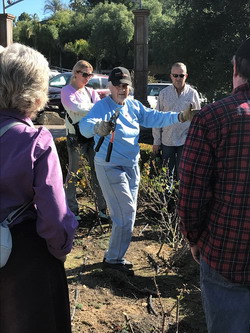
Virginia pruning |
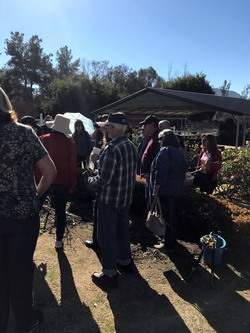
An attentive group |
See the Rose Haven Garden web page here. Click
here to see the Google map to Rose Haven Garden.
Temecula Valley Garden Club
Click here for their upcoming monthly meeting news.
Their Facebook page is here.
American Rose Trials Sustainability for 2020
by Linda Freeman
Plant Roses – Save Water
San Joaquin County Master Gardeners have been part of a National Rose Trial since 2018. The trial is part of the American Rose Trials for Sustainability (A.R.T.S.) program that has trial sites across the United States. It was initiated in 2012 by individuals representing multiple rose stakeholder groups, including: industry, the scientific community and public gardens. There are only two Mediterranean climate trial locations and both are in California. The trials at the Fullerton Arboretum started in 2019 and the UC Cooperative Extension office in San Joaquin County began in 2018.
The goal of the A.R.T.S. program is to identify roses that perform well in a given region when grown under "minimal input conditions." What do they mean by "minimal input conditions?"
• There are no pesticides used;
• We do not deadhead the flowers;
• There is no pruning (except to remove winter-killed canes in the spring or those killed by rodents);
• We do not add any fertilizer (only compost is added prior to planting);
• Plants are not covered in the winter (in colder climates it is common to cover and protect roses).
How does the trial work? Environmental Horticulture Advisor Karrie Reid has been managing and overseeing the San Joaquin trial since 2018. Their roses were planted in unused turf areas that were converted to the trial grounds. One of the selling features of converting the turf sections was the calculated water savings: 3,656 square feet of turf used 103,000 gallons of water, while 60 roses in the same area on drip use 6,175 gallons, a 94% savings. Trial sites are covered with a 3‑inch layer of wood mulch.
Each year starts a new trial with 20 cultivars. Three of each kind of rose are planted randomly throughout the beds with ample spacing between plants to observe natural plant habit. Mixed in with the 20 are two standards known to perform well and to be disease resistant. The trial runs for two years (evaluations start the year of planting and finishes the following year, so roses go through only one winter). We have two staggered trials planted in San Joaquin County.
Roses being tested in the A.R.T.S. trial may be watered thoroughly during the first year after planting for proper establishment during the season they were planted. The roses in the trial are watered 1‑inch, twice a week while they are blooming during the first year, and only once a week during the second year.
Each rose is evaluated twice monthly during the growing season by a team of San Joaquin UC Master Gardener volunteers, local rose club members or Karrie. They rate the roses on a 10‑point scale, judging them for their foliage, flowers and plant form. The evaluation data collected is then submitted to the A.R.T.S. program for evaluation.
Having the A.R.T.S. awards in different regions means that nursery and landscape professionals along with home gardeners can be sure they are selecting plants that will perform well in their neck of the woods. Not every plant is going to thrive in every climate. While a particular cultivar may do well in the short, cool growing season of Maine, it may perform very poorly in the much longer and warmer conditions found in California.
New trials start in January 2020.
Original Article by by Marcy Sousa, Special to The Record. If you would like to learn more about the A.R.T.S. program in a Mediterranean climate, and the winners, go to the American Rose Trials for Sustainability site. Information for this article was taken from the A.R.T.S. website, Nursery Management magazine and San Joaquin Master Gardener page.
Upcoming events
by Linda Freeman
WMWD Shade Trees for the Inland Empire
February 8 at 10 a.m. – 11:30 a.m.
WMWD Headquarters - Board Room
14205 Meridian Parkway, Riverside, CA, 92518
Choosing the right tree for the right place. Take away the guessing game of what trees will survive in the Inland Empire. Guest Speaker: Pam Pavela, Certified Arborist.
Cal Poly Pomona Annual Floriculture Plant Sale
February 29 at 10 a.m. – 2 p.m. (bring a cart)
Cal Poly Pomona Farm Store Nursery
4102 S University Dr., Pomona, CA 91768
(909) 869-4906
Hundreds of flowers for sale – many that will not come to market until 2021!
The sale is held even if it rains!
Rose Care FUNdamentals
by Frank Brines, Master Consulting Rosarian

In southern California winter is usually short and sometimes confusing. Winter for some plant life is a time of withdrawal that precedes renewal. For roses it is necessary to help them in that process. Now is the time to perform a few procedures to help reset the hormonal clock and get them ready for a great year of rose blooms. That's the main purpose for pruning.
According to all accounts and experienced rosarians, the proper time is "late winter." This has many meanings in an area like So Cal which has numerous weather zones. The important thing is you want to prune late enough to avoid risking frost damage to the tender growth that will emerge as a result of pruning. In most of the region my column is read the last average frost date is mid March, so that means you're probably safe pruning in mid to late February. It is always a gamble and the best advice is to watch the weather. If there is winter rain during January/February pruning can be held off awhile since these rains are cold making the ground colder and wetter than usual. This year the weather hasn't been severe enough to actually prevent new growth. I have observed that pruned or not new growth is appearing and buds forming an very short canes. Different parts of a yard may have other conditions effecting gardening. A south facing wall backing the plants will be warmer than a shadier area. Soil composition will have differing effects. A generous layer of remaining mulch will improve soil conditions.
If you haven't began or finished pruning, don't fear: There is still plenty of time to have blooms for rose shows or special spring events. The recent rainy periods and warmer-than-usual weather which has created a great environment for fungi diseases; please you examine your roses and, if you find any rust, remove all the leaves from the plant at once and discard into green waste bin. I do this anyway on every bush before pruning because it helps me see the structure clearly.
As I said before, the major late-winter pruning reset the plants' hormonal clock. A wake up call to begin a new life cycle-like restarting a factory. After this pruning, you can usually expect a flush of blooms 8 to 12 weeks later, depending on the temperatures during that period-the warmer it is, the shorter the time to blooms. But all things being equal, if you prune in the latter half of February you will likely have blooms for 2020 rose shows scheduled in mid- to late-April. If you would like blooms for a specific date, count backwards approximately 10 weeks from that date. Pruning should be complete on this date.
The following procedures mostly apply to hybrid teas and floribundas, but are reasonably serviceable for minis. They are not really applicable to climbers, ground cover roses, trailers, or shrub roses—all those types have their own pruning methods.
Before you prune, be sure you have good pruning tools and gloves with arm protectors, long handle loppers, and sharp clean "bypass" hand pruners. What does "bypass" mean? Take a look at your pruners: Bypass pruners have a sharp cutting blade (which slices through the cane) and a dull curved non-cutting blade (which holds the cane in place during the cut). The sharp blade "by passes" or over shoots the dull curved blade. It's a good idea to have a range of pruner sizes handy. Each size has a limit to the diameter thickness for which it is most efficiently used; using too small a pruner on too large a cane can damage both. At minimum, have a pair of loppers and a standard-sized pair of hand pruners that fit comfortably in your hand. A saw can be handy if you have some older plants with large canes that may need to be removed.
All tools should be kept clean, sharp, and in good repair. Rubbing alcohol is ideal for cleaning cutting blades, before and during the job. It also helps prevent transmitting diseases from plant to plant, and you can use it as first aid for punctures and scratches to your skin. A good pair of leather gloves are necessary with long sleeves or separate pair of sleeves to protect our arms.
Before starting the job, lubricate the moving parts with a little light oil (such as 3-in-1 oil), and make sure they operate without resistance. Sharpen each blade with a small diamond file (available at garden centers), trying as much as possible to match the original bevel of the blade. Every 100 cuts or so, swipe the file over the blade a few times to keep it sharp. If you notice that the pruners are crushing the stems and/or leaving a tail, it's past time to sharpen! To minimize damage to the cane keep this rule in mind: The sharp blade should always face the part that will be left. This will minimize the crushing of the cane or stem as it will be the part that is discarded. This rule also works for preparing stems for arranging or putting into a vase.
Now, decide what style of pruning you feel comfortable with (Figure 1). I find this works well with the way buds are distributed along the cane. Buds are found in the "axil" where a leaf meets the cane; leaves spiral around the cane at about 1.5" intervals. This places outward-facing buds about 4" apart. If you prune lightly to moderately, and if frost damages the tender young growth, then you can still re-prune to the next bud down.

In Southern California our rose bushes can grow quite large, so start with some gross pruning to bring the project down to size. I use loppers to cut every bush down to about 3 feet high. This lets you examine the structure of the bush, and to use your hand pruners to more easily remove canes that are twiggy, dead, crossing other canes, or passing through the center of the plant. Also remove old leaves as you go along so you can easily see the structure of the plant. After removing all that stuff from the interior of the bush you can do the final pruning. Attempt to leave a domed top to the degree possible so the plant will bush out in a pleasing, balanced manner.
You will make two kinds of cuts. Some cuts remove an entire branch; make these flush with the surface of the parent cane. Other cuts simply shorten a cane. It is important to position your pruners so you minimize damage to the plant. Position your pruners so the non-cutting blade is in contact with the portion of the cane that will be removed, and the cutting blade is on the side of the cut that will remain on the plant. (See Figure 2.) This will make more sense when you are actually holding the pruners and getting ready to cut! Also, always prune above an outward facing bud with an angled cut. (See Figure 3).
For shrub roses, cut them back to conform to the space you want them to fill, inspect and clean out dead and diseased material from the center, shorten canes and remove about one third of the growth.
A word of caution when pruning: Look for the small nests of hummingbirds, as this is the nesting period for two varieties in our area. Also, if you discover praying mantis egg cases on any branches you remove, find a place to put them where they will be undisturbed and hatch out so you can benefit from the offspring!
Clean the ground thoroughly of all rose debris and dispose of all cuttings and other materials in your green waste bin and put it on the street: Do not compost it! Apply a dormant spray to the plants and the soil surface to ward off diseases. Then apply 2"-4" of composted mulch to cover the entire garden area.
The first fertilizing will be when new growth is about 2 inches long. I recommend lower values of the three elements (Nitrogen [3], Phosphate [4],K Potassium [3]) with slightly higher value for Phosphate. In two weeks begin with heavier feeding every 2 weeks for great blooms or at least monthly. Now would be the best time to asses the irrigation system for any needed repairs while there is no new growth and mulch has not been spread.
For more ideas, visit TVRS' Rose Haven Heritage Garden. Click here to see the map to Rose Haven Garden in Temecula, as well as our Society web site at Temecula Valley Rose Society.org. Spread the joy of roses!

